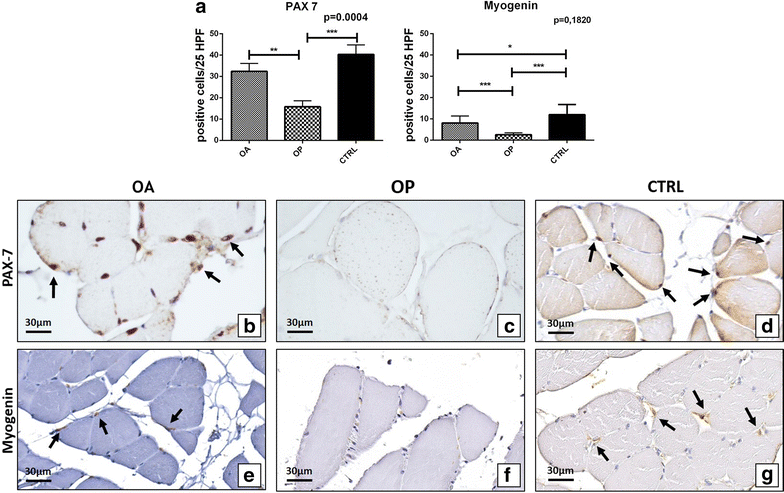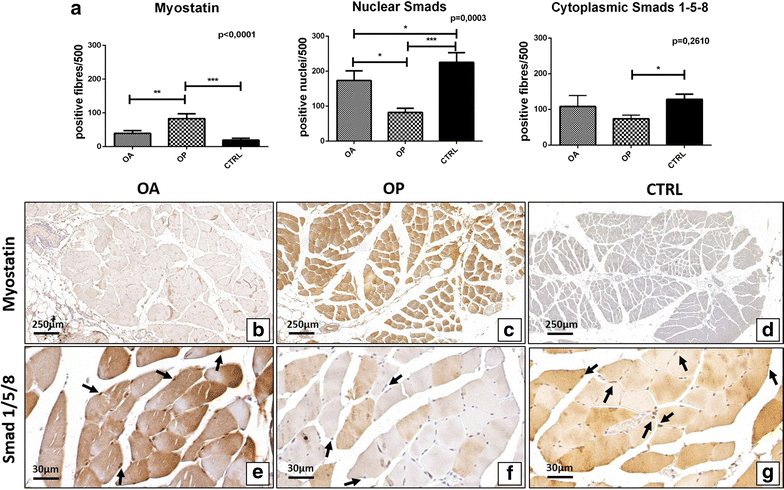Bone Morphogenetic Proteins and myostatin pathways: key mediator of human sarcopenia
- PMID: 28202082
- PMCID: PMC5310081
- DOI: 10.1186/s12967-017-1143-6
Bone Morphogenetic Proteins and myostatin pathways: key mediator of human sarcopenia
Abstract
Background: Sarcopenia, osteoporosis and osteoarthritis are the most frequent musculoskeletal disorders affecting older people. The main aim of this study was to test the hypothesis that the balance between BMPs and myostatin pathways regulates the age-related muscle degeneration in OP and OA patients. To this end, we investigated the relationship among the expression of BMP-2/4-7, myostatin and phosphorylated Smads1-5-8 and the muscle quality, evaluated in term of fibers atrophy and satellite cells activity.
Methods: In this retrospective study, we collected 123 biopsies of vastus lateralis: 48 biopsies from patients who underwent hip arthroplasty for subcapital fractures of the femur (OP), 55 biopsies from patients who underwent hip arthroplasty for osteoarthritis (OA) and 20 biopsies from patients who underwent hip arthroplasty for high-energy hip fractures (CTRL). Muscle biopsies were fixed in 4% paraformaldehyde and paraffin embedded. Serial sections were used for morphometrical and immunohistochemical analysis (BMP/2/4-7, myostatin, Smads1-5-8, Pax7 and myogenin). In addition, 1 mm3 of muscle tissue of each patient was embedded in epon for ultrastructural study.
Results: Morphometric data indicated an increase of the number of atrophic fibers in OP patients compare to OA. In line with these data, we found an high regenerative potential in muscle tissues of OA patients due to the significant amount of both Pax7 and myogenin positive satellite cells detected in OA group. In addition, our data showed the decrease of BMP2/4 and -7 expression in OP patients compared to both OA group and CTRL. Conversely, OP patients were characterized by high levels of myostatin expression. A different expression profile was also found for phosphorylated Smad1-5-8 between OP and OA patients. In particular, OP patients showed a low number of positive phosphorylated Smad1-5-8 nuclei.
Conclusion: The identification of molecular pathways involved in the pathogenesis of sarcopenia open new prospective for the development of drugs able to prevent/treat the muscle impairment that occur in elderly. Results here reported, highlighting the role of BMPs and myostatin pathways in physio-pathogenesis of human sarcopenia, allow us to propose human recombinant BMP-2/7 and anti-myostatin antibodies as a possible therapeutic option for the sarcopenia.
Figures






Similar articles
-
Sarcopenia: a histological and immunohistochemical study on age-related muscle impairment.Aging Clin Exp Res. 2015 Oct;27 Suppl 1:S51-60. doi: 10.1007/s40520-015-0427-z. Epub 2015 Jul 22. Aging Clin Exp Res. 2015. PMID: 26197719
-
The role of sarcopenia with and without fracture.Injury. 2016 Oct;47 Suppl 4:S3-S10. doi: 10.1016/j.injury.2016.07.057. Epub 2016 Aug 3. Injury. 2016. PMID: 27496721
-
Effects of Simulated Microgravity on Muscle Stem Cells Activity.Cell Physiol Biochem. 2020 Aug 5;54(4):736-747. doi: 10.33594/000000252. Cell Physiol Biochem. 2020. PMID: 32749090
-
Sarcopenia--The search for emerging biomarkers.Ageing Res Rev. 2015 Jul;22:58-71. doi: 10.1016/j.arr.2015.05.001. Epub 2015 May 8. Ageing Res Rev. 2015. PMID: 25962896 Review.
-
Bone morphogenetic proteins.Growth Factors. 2004 Dec;22(4):233-41. doi: 10.1080/08977190412331279890. Growth Factors. 2004. PMID: 15621726 Review.
Cited by
-
DNA Methylation Signatures of Bone Metabolism in Osteoporosis and Osteoarthritis Aging-Related Diseases: An Updated Review.Int J Mol Sci. 2021 Apr 19;22(8):4244. doi: 10.3390/ijms22084244. Int J Mol Sci. 2021. PMID: 33921902 Free PMC article. Review.
-
Revisiting Skeletal Muscle Dysfunction and Exercise in Chronic Obstructive Pulmonary Disease: Emerging Significance of Myokines.Aging Dis. 2023 Dec 7;15(6):2453-2469. doi: 10.14336/AD.2023.1125. Aging Dis. 2023. PMID: 38270119 Free PMC article. Review.
-
Body Composition Findings by Computed Tomography in SARS-CoV-2 Patients: Increased Risk of Muscle Wasting in Obesity.Int J Mol Sci. 2020 Jun 30;21(13):4670. doi: 10.3390/ijms21134670. Int J Mol Sci. 2020. PMID: 32630032 Free PMC article.
-
Current Methods for Skeletal Muscle Tissue Repair and Regeneration.Biomed Res Int. 2018 Apr 16;2018:1984879. doi: 10.1155/2018/1984879. eCollection 2018. Biomed Res Int. 2018. PMID: 29850487 Free PMC article. Review.
-
Skeletal muscle myostatin gene expression and sarcopenia in overweight and obese middle-aged and older adults.JCSM Clin Rep. 2021 Oct;6(4):137-142. doi: 10.1002/crt2.43. Epub 2021 Sep 23. JCSM Clin Rep. 2021. PMID: 35311023 Free PMC article.
References
-
- Rosenberg IH. Summary comments. Am J Clin Nutr. 1989;50:1231–1233.
-
- Rosenberg IH. Sarcopenia: origins and clinical relevance. J Nutr. 1997;127(5 Suppl):990S–991S. - PubMed
-
- Piscitelli P, Brandi ML, Tarantino U, Baggiani A, Distante A, Muratore M, Grattagliano V, Migliore A, Granata M, Guglielmi G, Gimigliano R, Iolascon G. Incidence and socioeconomic burden of hip fractures in Italy: extension study 2003–2005. Reumatismo. 2010;62(2):113–118. - PubMed
Publication types
MeSH terms
Substances
LinkOut - more resources
Full Text Sources
Other Literature Sources
Miscellaneous

